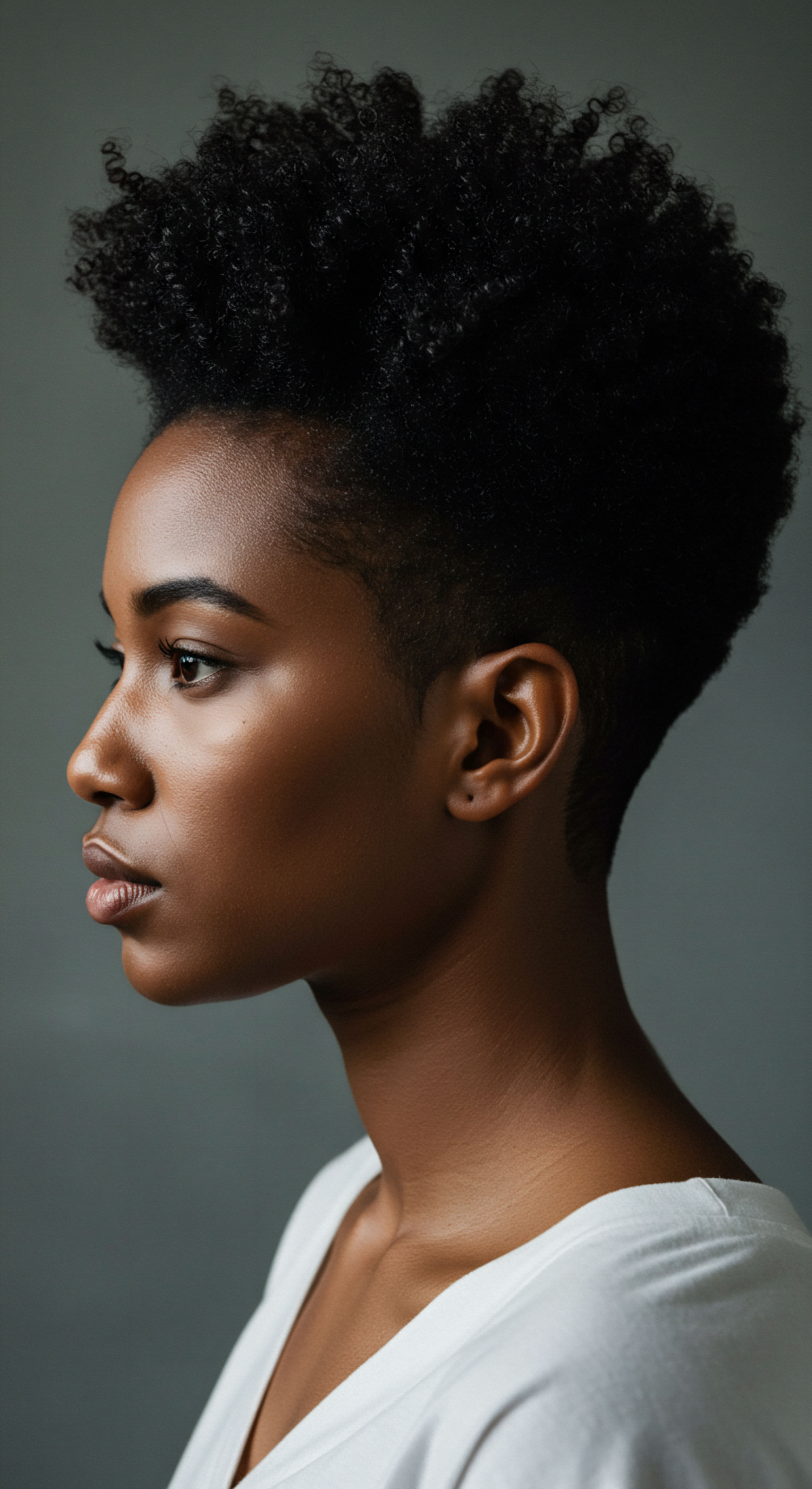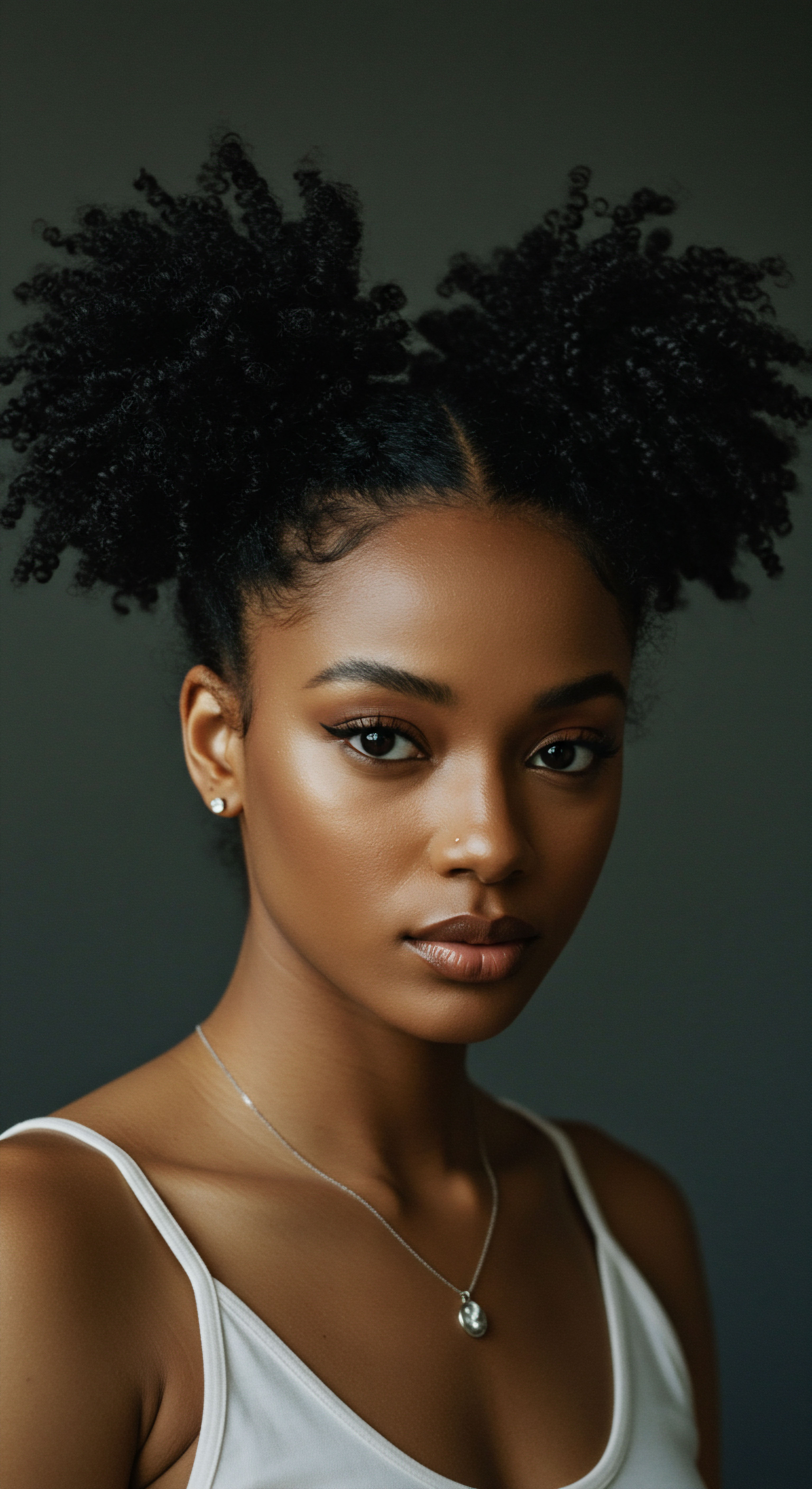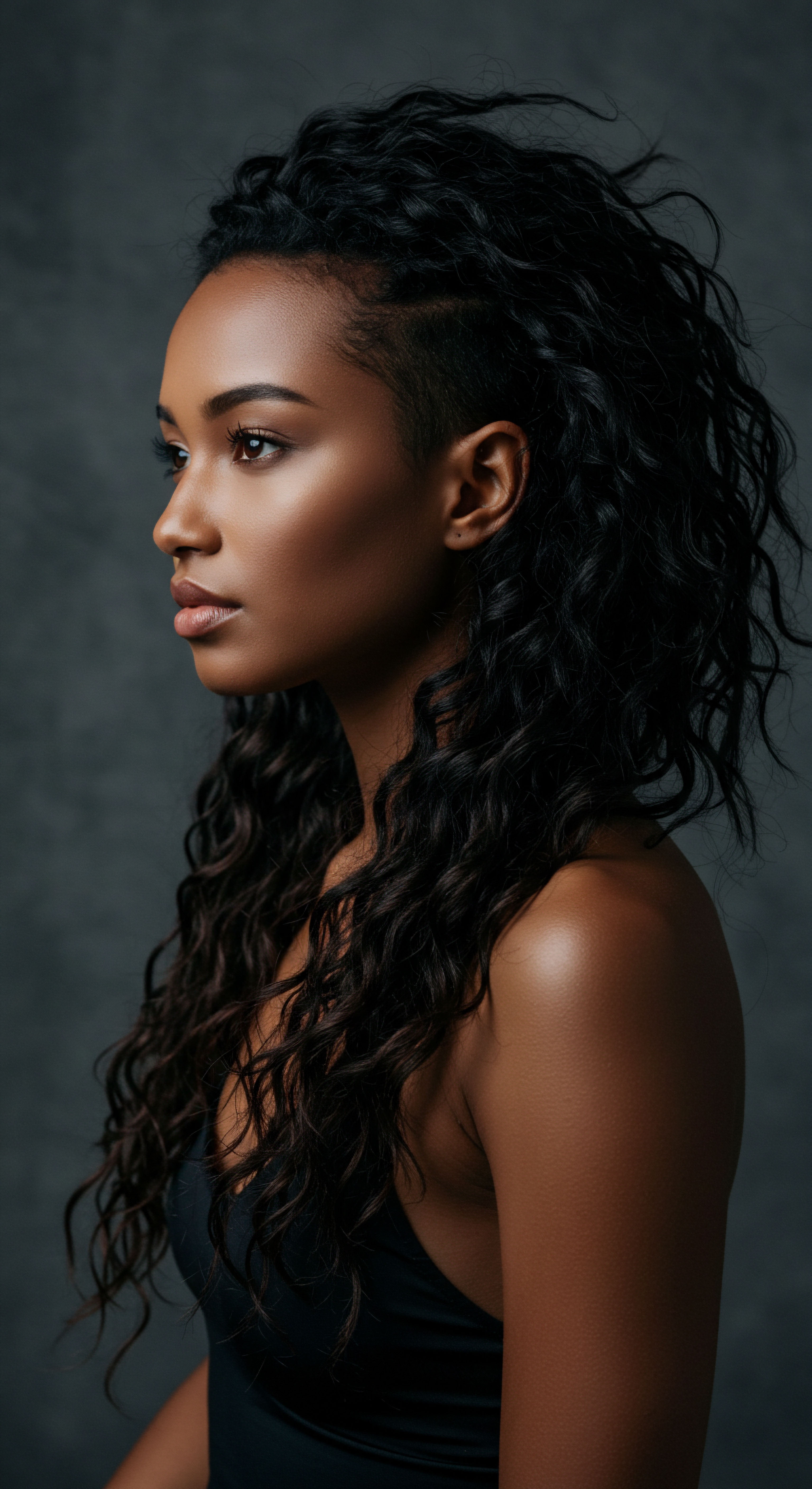
Roots
The quiet language of hair, a conversation whispered across generations, speaks volumes about who we are and how we stand in the world. Long before the advent of modern salons and the dazzling array of products lining our shelves, hair care was an intimate act, deeply embedded within the fabric of daily existence. It was a ritual, a marker, a declaration of belonging, often reflecting the subtle shifts in life’s journey. The way strands were tended, adorned, or presented carried meanings far beyond mere aesthetics.
Consider the profound connection between personal identity and the ancient practices that shaped how hair was perceived and cared for. These traditions, born from necessity, spiritual belief, and communal bonds, laid the groundwork for our contemporary understanding of self through hair.

The Hair’s Own Language
Each curl, coil, or wave possesses a unique architecture, a testament to the biological marvel that is textured hair. Understanding this inherent structure forms the very bedrock of respectful care. From the tightly wound helix of a coily strand to the gentle undulation of a wavy pattern, variations exist even within a single head of hair. This diversity, rather than a deviation, represents a spectrum of beauty.
Historically, hair characteristics were often indicators of lineage, community standing, or even life events. Ancient African societies, for example, utilized intricate hairstyles as a visual lexicon, communicating marital status, age, or tribal affiliation. Such practices underscore a truth often overlooked today ❉ hair possesses a language of its own, a silent narrative of heritage and personal story.
The anatomy of textured hair, distinct in its follicular structure and growth pattern, demands a specific approach to care. The elliptical shape of the follicle, for instance, dictates the curl’s tightness, while the distribution of disulfide bonds contributes to its characteristic resilience and curl retention. Acknowledging these biological realities moves us beyond superficial categorizations, allowing for a deeper appreciation of the hair’s intrinsic needs.
Hair’s quiet language speaks of heritage and personal story, a conversation whispered across generations.

Ancient Echoes in Modern Strands
The history of hair is a living archive, its pages filled with practices that continue to resonate in our modern lives. In various cultures, hair was not simply an adornment; it was a repository of power, a connection to the divine, or a symbol of life’s transitions. For many Native American tribes, long hair signified strength and a connection to ancestral wisdom, often cut only during periods of mourning or significant life changes.
Similarly, in ancient India, ritual shaving during initiation ceremonies marked a profound transition from one social status to another, stripping away previous identities to signify rebirth into a new role. These historical echoes demonstrate how traditional hair care practices were deeply intertwined with societal roles, spiritual beliefs, and personal transformations.
The very concept of hair as a symbol of self-worth is not a modern construct. Research indicates that across diverse cultures and historical periods, hair has been a potent indicator of social status, gender, and personal expression. The choices made regarding hair, even centuries ago, were rarely arbitrary; they were deliberate acts of communication, projecting identity to the world.
- Follicle Shape ❉ The unique elliptical structure of the follicle in textured hair determines the curl pattern, from loose waves to tight coils.
- Disulfide Bonds ❉ A higher density of these bonds in Afro hair contributes to its distinct structure and inherent resilience.
- Scalp Health ❉ Traditional practices often prioritized scalp well-being, recognizing it as the foundation for healthy hair growth.

What Did Hair Mean in Ancient Societies?
Across ancient civilizations, hair served as a potent canvas for cultural expression, embodying societal norms and individual beliefs. In ancient Egypt, elaborate wigs and intricate braids were not merely fashion statements; they functioned as explicit indicators of an individual’s position within the complex social hierarchy. These styles, meticulously crafted, differentiated between various classes and roles, serving as visual markers of societal standing. The careful maintenance of hair in these societies was a reflection of status, often requiring significant time and resources.
In Chinese culture, traditional hairstyles determined social status, marital standing, and even eligibility for certain positions. The precise techniques involved in these ancient styles were considered a reflection of personal identity and collective values. Similarly, in medieval Europe, hairstyles carried religious connotations, mirroring the prevailing societal values of the time.
Such examples illustrate a universal truth ❉ hair, throughout history, has been far more than a physical attribute. It has been a powerful medium for non-verbal communication, shaping perceptions and reinforcing social order.

Ritual
As we turn our attention from the fundamental nature of hair to the deliberate acts of its care, a new understanding begins to unfold. The daily or weekly practices we engage in, whether inherited or learned, are more than simple routines; they are rituals. These rituals, often steeped in the wisdom of past generations, sculpt not only our strands but also our sense of self.
They invite a gentle contemplation of technique and intention, guiding us toward a deeper, more personal connection with our hair. Here, the practical wisdom of care meets the profound influence of tradition, shaping how we present ourselves to the world.

Styling as a Storytelling Medium
The very act of styling textured hair is a form of storytelling, a continuation of practices passed down through family lines and cultural communities. Consider the enduring legacy of cornrows in African heritage. Beyond their functional role in protecting hair, these intricate patterns carry profound cultural meaning, reflecting identity and lineage.
They served as tools of resistance during the transatlantic slave trade, with specific designs used to convey messages or even map escape routes. This historical context elevates styling from a mere aesthetic choice to a powerful act of cultural preservation and self-assertion.
The deliberate choice of a protective style, such as braids or twists, extends beyond immediate hair health. It often represents a conscious alignment with ancestral practices, a way to honor heritage while safeguarding delicate strands from environmental stressors. These styles, requiring patience and skill, often involve communal effort, strengthening bonds within families and communities. The shared experience of braiding, for instance, frequently fosters meaningful connections between elders and younger generations, transmitting cultural knowledge alongside practical techniques.
Styling textured hair is a storytelling medium, a continuation of cultural practices and family traditions.

The Purpose of Nighttime Care
The transition from day to night introduces a different rhythm of care, one focused on protection and restoration. Nighttime rituals for textured hair, often involving the use of silk or satin bonnets, scarves, or pillowcases, are not merely modern conveniences. They are echoes of a long-standing understanding that hair requires safeguarding during periods of rest.
The friction from cotton pillowcases can lead to breakage and moisture loss for delicate hair strands. The silken barrier minimizes this friction, allowing the hair to retain its natural oils and moisture, thus preserving its integrity and style.
This wisdom, passed down through generations, underscores a holistic approach to hair wellness. It acknowledges that true hair health extends beyond washing and conditioning to encompass every moment, including slumber. The ritual of preparing hair for rest becomes an act of gentle self-care, a quiet acknowledgment of the hair’s needs and its contribution to overall well-being.
- Silk Bonnets ❉ Offer a smooth surface to minimize friction, reducing breakage and preserving hair’s natural moisture.
- Protective Styles ❉ Techniques like braids, twists, and buns shield hair from environmental damage and manipulation.
- Moisture Sealing ❉ Applying leave-in conditioners or oils before bed helps lock in hydration, supporting strand elasticity.

How Does Daily Care Reflect Self-Perception?
The seemingly simple acts of daily hair care hold a mirror to our inner world, reflecting how we perceive ourselves and how we wish to be perceived by others. The time and attention devoted to cleansing, detangling, and styling are not solely about external presentation; they are deeply personal acts that influence self-esteem and confidence. Research suggests a direct link between well-maintained hair and higher confidence levels, highlighting that hair grooming practices can significantly affect self-perception. A positive hair experience can elevate mood, enhance social interactions, and contribute to an overall sense of well-being.
Conversely, periods of stress or insecurity may manifest through hair neglect, or even drastic, impulsive cuts. This interplay between our hair and our emotional state suggests that hair care rituals are a tangible form of self-care. By treating hair with thoughtful attention, individuals reinforce a message of self-worth, cultivating a more positive self-image.
The choice to wear natural textures, for example, often signals a statement of self-love and resistance against societal pressures to conform to Eurocentric beauty standards. This decision, deeply personal, speaks volumes about individual values and a commitment to authenticity.

Relay
Stepping into the deeper currents of hair’s influence, we find ourselves at a nexus where ancestral wisdom, scientific understanding, and contemporary identity converge. The question of how traditional hair care shapes modern identity expands beyond mere aesthetics, inviting us to consider the intricate interplay of biological, psychological, social, and cultural factors. Here, the dialogue becomes more complex, requiring a thoughtful examination of how historical narratives continue to inform present-day experiences and perceptions.

The Weight of Historical Expectations
The historical context of hair care, particularly for Black and mixed-race individuals, carries a significant weight that continues to shape modern identity. During the transatlantic slave trade, the deliberate stripping of traditional hair care practices served as a tool of dehumanization and cultural erasure. Enslaved Africans, separated from their communities and the communal rituals of hair styling, found their natural hair deemed “unprofessional” or “bad” in contrast to Eurocentric beauty standards. This oppressive narrative persisted for centuries, compelling many Black women to chemically alter their hair texture or cover it with wigs and extensions to conform to dominant societal norms.
The legacy of this historical pressure continues to influence self-perception and identity today. A study published in Nouvelles pratiques sociales highlights that when natural Black hairstyles are used to deny rights or opportunities, it amounts to racism, affecting the well-being of people of African descent. This historical burden underscores the profound impact of traditional hair care on identity, demonstrating how past injustices reverberate through contemporary experiences. The act of embracing natural hair today often represents a powerful act of self-acceptance and resistance, reclaiming a heritage once suppressed.
| Historical Period Ancient African Societies |
| Hair's Societal Role Communicated social status, age, lineage. |
| Impact on Identity Affirmed community belonging, personal standing. |
| Historical Period Transatlantic Slave Trade |
| Hair's Societal Role Dehumanization, forced conformity to Eurocentric norms. |
| Impact on Identity Suppressed cultural identity, fostered internalized negativity. |
| Historical Period Civil Rights Movement (1960s-70s) |
| Hair's Societal Role Symbol of Black pride, resistance, political statement. |
| Impact on Identity Reclamation of heritage, collective identity formation. |
| Historical Period Modern Era (Post-CROWN Act) |
| Hair's Societal Role Continued fight against discrimination, celebration of diversity. |
| Impact on Identity Self-love, individual expression, ongoing advocacy for acceptance. |
| Historical Period Hair's meaning shifts across historical periods, reflecting broader societal values and power dynamics. |

How Does Science Inform Our Hair Choices?
Beyond the visible surface, the science of hair provides a deeper understanding that empowers informed choices. The unique characteristics of textured hair, such as its varied curl patterns and susceptibility to dryness, are rooted in its microscopic structure. For example, the oval shape of the hair follicle produces hair that curls upon itself, leading to the characteristic coily or kinky appearance. This structure also means that the cuticle layers, which protect the hair’s inner cortex, may not lie as flat as in straight hair, making textured hair more prone to moisture loss and tangling.
Understanding the hair’s porosity, its ability to absorb and retain moisture, becomes a guiding principle in product selection and care regimens. Low porosity hair, with tightly bound cuticles, may resist moisture but also holds it well once absorbed. High porosity hair, with more open cuticles, readily absorbs moisture but also loses it quickly.
Knowing these scientific distinctions allows individuals to select ingredients and techniques that genuinely support their hair’s health, moving beyond generic advice to truly personalized care. This scientific literacy transforms routine care into a thoughtful application of knowledge, fostering a deeper connection with one’s own strands.
The scientific understanding of hair’s composition also sheds light on the potential impact of certain styling practices. For instance, a recent study has raised concerns regarding the synthetic hair used in braiding, suggesting that continuous contact with certain chemicals in these extensions could have health implications. James Rogers, head of product safety testing at Consumer Reports, notes that while more research is needed, exposure to harmful chemicals is cumulative. This data point, though still under investigation, highlights the importance of critically evaluating modern hair products and materials, balancing aesthetic desires with health considerations.

The Cultural Politics of Hair
Hair is rarely apolitical. Its presentation, especially for Black and mixed-race individuals, has historically been, and continues to be, a site of cultural and political discourse. The natural hair movement, which gained significant momentum in the early 2000s, emerged as a direct response to centuries of societal pressure to conform to Eurocentric beauty ideals. This movement advocated for the acceptance and celebration of natural hair textures and styles, becoming a powerful symbol of self-love, racial pride, and resistance.
Legislation like the CROWN Act (Creating a Respectful and Open World for Natural Hair), passed in several US states, explicitly prohibits discrimination based on hair texture or protective styles. This legal recognition underscores the deeply ingrained biases that have historically marginalized natural hair. The ongoing fight for hair freedom illustrates how traditional care practices and aesthetic preferences are intertwined with broader social justice movements.
It speaks to a collective journey toward authentic self-expression, where identity is affirmed and celebrated, rather than suppressed, by the very strands that grow from one’s head. The cultural politics of hair reveal how personal choices about appearance are often reflections of larger societal dialogues about acceptance, power, and belonging.
Consider the subtle yet profound impact of hair discrimination on psychological well-being. A study examining Black women in the UK found that hair practices ranged from transformations aimed at preventing discrimination to choosing styles according to cultural identity and political values. This research highlights the constant negotiation of personal and social identity influenced by hair, particularly in light of historical dominance of Eurocentric beauty standards. The persistent pressure to manipulate natural hair to resemble straighter textures, following centuries of oppressive norms, can significantly impact self-perception and mental health.
- Racial Identity ❉ Hair texture and styling choices are deeply connected to racial identity development, particularly for Black women.
- Self-Esteem ❉ Dissatisfaction with hair is linked to lower self-esteem, underscoring hair’s role in self-perception.
- Social Acceptance ❉ Hair presentation can influence social acceptance and opportunities, highlighting the ongoing societal biases.

Reflection
The journey through hair’s deep roots, its rhythmic rituals, and its far-reaching relay into modern identity reveals a profound truth ❉ our strands are more than just physical attributes. They are living extensions of our stories, our heritage, and our evolving selves. Each choice, each gentle stroke of a brush, each silken wrap at night, becomes a quiet affirmation of who we are and who we aspire to be.
This ongoing dialogue between tradition and individual expression, between the collective past and the personal present, shapes a unique landscape of selfhood. In this delicate dance, where science meets spirit and history informs the now, we discover that caring for our hair is truly caring for a piece of our deepest identity.

References
- Byrd, A. D. & Tharps, L. D. (2001). Hair Story ❉ Untangling the Roots of Black Hair in America. St. Martin’s Press.
- Caldwell, P. M. (1991). A Hair Piece ❉ Perspectives on the Intersection of Race and Gender. Duke Law Journal, 1991(2), 365-416.
- Delaney, C. (1994). Untangling the Meanings of Hair in Turkish Society. Anthropological Quarterly, 67(4), 159-172.
- Dove, L. M. & Powers, L. E. (2018). Exploring the Complexity of Hair and Identity Among African American Female Adolescents in Foster Care. Children and Youth Services Review, 95, 368-376.
- Jacobs-Huey, L. (2006). The New Negroes and Their Hair ❉ Hairdressing, Political Aesthetics, and African American Identity. Rutgers University Press.
- Johnson, T. & Bankhead, T. (2014). Hair It Is ❉ Examining the Experiences of Black Women with Natural Hair. Open Journal of Social Sciences, 2(1), 86-100.
- Joseph-Salisbury, R. & Connelly, L. (2018). “If Your Hair is Relaxed, White People Are Relaxed. If Your Hair is Nappy, They’re Not Happy” ❉ Black Hair as a Site of “Post-Racial” Social Control in English Schools. Social Sciences, 7(11), 219.
- Pergament, D. (1999). It’s Not Just Hair ❉ Historical and Cultural Considerations for an Emerging Technology. Chicago-Kent Law Review, 75(1), 41-72.
- Rajan-Rankin, S. (2021). “I am now being who I am and I’m proud of it” ❉ Hair related personal and social identity and subjective wellbeing of older Black women in the UK. Journal of Women & Aging, 33(5), 502-519.
- Rooks, N. M. (1996). Hair Raising ❉ Beauty, Culture, and African American Women. Rutgers University Press.
- Sherrow, V. (2001). Encyclopedia of Hair ❉ A Cultural History. Greenwood Press.
- Synnott, A. (1987). Shame and Glory ❉ A Sociology of Hair. British Journal of Sociology, 38(3), 381-413.
- Thompson, C. (2008). Black Women and Identity ❉ What’s Hair Got to Do With It?. Michigan Feminist Studies, 22(1).
- Weitz, R. (2004). Rapunzel’s Daughters ❉ What Women’s Hair Tells Us about Women’s Lives. Farrar, Straus and Giroux.